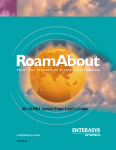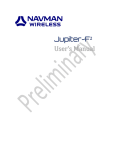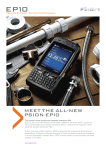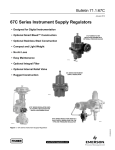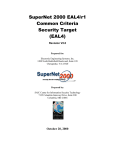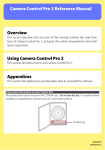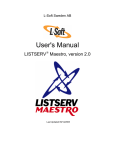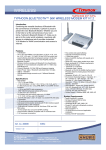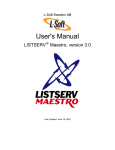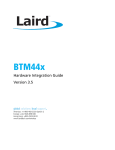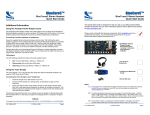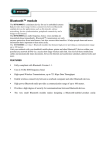Download BlueCore∆ Headset Configuration Tool User Guide
Transcript
_äìÉ`çêÉ∆ Headset Configuration Tool User Guide Issue 1 Cambridge Silicon Radio Limited Churchill House Cambridge Business Park Cowley Road Cambridge CB4 0WZ United Kingdom Registered in England and Wales 3665875 Tel: +44 (0)1223 692000 Fax: +44 (0)1223 692001 www.csr.com CS-207370-UGP1 © Cambridge Silicon Radio Limited 2010 This material is subject to CSR’s non-disclosure agreement. Document History Document History Revision Date 1 15 JUL 10 History Original publication of this document. _äìÉ`çêÉ Headset Configuration Tool User Guide Contacts General information Information on this product Customer support for this product More detail on compliance and standards Help with this document CS-207370-UGP1 www.csr.com [email protected] www.csrsupport.com [email protected] [email protected] © Cambridge Silicon Radio Limited 2010 This material is subject to CSR’s non-disclosure agreement. Page 2 of 27 Trademarks, Patents and Licences Trademarks, Patents and Licences Unless otherwise stated, words and logos marked with ™ or ® are trademarks registered or owned by CSR plc and/or its affiliates. Bluetooth® and the Bluetooth logos are trademarks owned by Bluetooth SIG, Inc. and licensed to CSR. The publication of this information does not imply that any licence is granted under any patent or other rights owned by CSR plc and/or its affiliates. CSR reserves the right to make technical changes to its products as part of its development programme. While every care has been taken to ensure the accuracy of the contents of this document, CSR cannot accept responsibility for any errors. No statements or representations in this document are to be construed as advertising, marketing, or offering for sale in the United States imported covered products subject to the Cease and Desist Order issued by the U.S. International Trade Commission in its Investigation No. 337-TA-602. Such products include SiRFstarIII™ chips ® that operate with SiRF software that supports SiRFInstantFix™, and/or SiRFLoc servers, or contains SyncFreeNav functionality. IMA ADPCM compression/decompression algorithms Copyright Notice Copyright 1992 by Stichting Mathematisch Centrum, Amsterdam, The Netherlands. All Rights Reserved Permission to use, copy, modify, and distribute this software and its documentation for any purpose and without fee is hereby granted, provided that the above copyright notice appear in all copies and that both that copyright notice and this permission notice appear in supporting documentation, and that the names of Stichting Mathematisch Centrum or CWI not be used in advertising or publicity pertaining to distribution of the software without specific, written prior permission. STICHTING MATHEMATISCH CENTRUM DISCLAIMS ALL WARRANTIES WITH REGARD TO THIS SOFTWARE, INCLUDING ALL IMPLIED WARRANTIES OF MERCHANTABILITY AND FITNESS, IN NO EVENT SHALL STICHTING MATHEMATISCH CENTRUM BE LIABLE FOR ANY SPECIAL, INDIRECT OR CONSEQUENTIAL DAMAGES OR ANY DAMAGES WHATSOEVER RESULTING FROM LOSS OF USE, DATA OR PROFITS, WHETHER IN AN ACTION OF CONTRACT, NEGLIGENCE OR OTHER TORTIOUS ACTION, ARISING OUT OF OR IN CONNECTION WITH THE USE OR PERFORMANCE OF THIS SOFTWARE. No statements or representations in this document are to be construed as advertising, marketing, or offering for sale in the United States imported covered products subject to the Cease and Desist Order issued by the U.S. International Trade Commission in its Investigation No. 337-TA-602. Such products include SiRFstarIII™ chips ® that operate with SiRF software that supports SiRFInstantFix™, and/or SiRFLoc servers, or contains SyncFreeNav functionality. Life Support Policy and Use in Safety-critical Compliance CSR’s products are not authorised for use in life-support or safety-critical applications. Use in such applications is done at the sole discretion of the customer. CSR will not warrant the use of its devices in such applications. Performance and Conformance Refer to www.csrsupport.com for compliance and conformance to standards information. CS-207370-UGP1 © Cambridge Silicon Radio Limited 2010 This material is subject to CSR’s non-disclosure agreement. Page 3 of 27 _äìÉ`çêÉ Headset Configuration Tool User Guide Other products, services and names used in this document may have been trademarked by their respective owners. Contents Contents Document History ................................................................................................................................................. 2 Contacts................................................................................................................................................................. 2 Trademarks, Patents and Licences ..................................................................................................................... 3 Life Support Policy and Use in Safety-critical Compliance............................................................................... 3 Performance and Conformance........................................................................................................................... 3 1 Introduction .................................................................................................................................................... 5 1.1 General.................................................................................................................................................... 5 2 Description of Headset Configuration Tool Workspace ............................................................................. 6 2.1 Device Platform ....................................................................................................................................... 7 3 2.2 Functionality ............................................................................................................................................ 8 2.2.1 File Menu ..................................................................................................................................... 8 2.2.2 Output Menu ................................................................................................................................ 8 2.2.3 Properties Menu........................................................................................................................... 9 2.2.4 View Menu ................................................................................................................................... 9 2.2.5 Help Menu.................................................................................................................................... 9 Opening a Default Configuration................................................................................................................ 10 4 Advanced Configuration Parameters ......................................................................................................... 11 4.1 Features Tab ......................................................................................................................................... 11 4.2 User Events Tab.................................................................................................................................... 12 4.3 LEDs (States) Tab ................................................................................................................................. 13 4.4 LEDs (Events) Tab ................................................................................................................................ 14 4.5 LEDs (Filters) Tab ................................................................................................................................. 15 4.6 Timers Tab ............................................................................................................................................ 16 4.7 Audio Tones Tab ................................................................................................................................... 17 4.8 Audio Gains Tab.................................................................................................................................... 18 4.9 HFP FeaturesTab .................................................................................................................................. 19 4.10 Battery Tab ............................................................................................................................................ 20 4.11 Input/Output Tab.................................................................................................................................... 21 4.12 Voice Prompts Tab ................................................................................................................................ 22 4.12.1 Using the Voice Prompts Tab .................................................................................................... 22 4.13 User Defined Tones Tab........................................................................................................................ 24 4.14 Buttons .................................................................................................................................................. 25 5 Document References ................................................................................................................................. 26 Terms and Definitions ........................................................................................................................................ 27 CS-207370-UGP1 © Cambridge Silicon Radio Limited 2010 This material is subject to CSR’s non-disclosure agreement. Page 4 of 27 _äìÉ`çêÉ Headset Configuration Tool User Guide Contents ................................................................................................................................................................ 4 Introduction 1 Introduction This document describes the Configuration Tool for CSR’s Bluetooth Headset applications. It is a generic description of the Configuration Tool and specific details may vary slightly between particular versions of the Configuration Tool. Note: The Headset Configuration Tool is a user-friendly tool developed to configure Headset applications. To allow manufacturers to distinguish their final product in the market place the Headset software is designed with a highly configurable HMI. Developers can readily: Define PIO functionality to suit their hardware design. Associate device control with different button configurations. Define unique LED patterns and audio tones to indicate: 1.1 User actions System states System events General The Headset Configuration Tool is designed to simplify the customisation of the supported Headset configurable HMI settings. PS Key configuration settings can be read into the Headset Configuration Tool from the default options, a previously saved user-generated .psr file or a connected device. Default configurations are provided for two, three and four-button headset designs. When the Headset Configuration Tool is opened, developers can select the button configuration that matches their hardware design and suitable default settings for the selected hardware design are loaded into the Headset Configuration Tool application. Note: The default button assignment, functionality and user events can then be viewed in the User Events tab. The default settings provide a viable HMI that can be used as supplied or can be customised, by the manufacturer, using the Headset Configuration Tool Advanced option in the View menu. Settings defined in the Headset Configuration Tool can be saved as a .psr file or downloaded directly to the Persistent Store of a connected device. CS-207370-UGP1 © Cambridge Silicon Radio Limited 2010 This material is subject to CSR’s non-disclosure agreement. Page 5 of 27 _äìÉ`çêÉ Headset Configuration Tool User Guide This document should be read in conjunction with the specific Headset Configuration PS Key Bit Field document for the relevant application(s). Description of Headset Configuration Tool Workspace 2 Description of Headset Configuration Tool Workspace The Headset Configuration Tool supports two modes of operation: Simple mode: Allows configuration values for default two, three and four-button headsets to be loaded into the Headset Configuration Tool, and the input and output PIOs corresponding to the hardware design to be assigned. Advanced mode: Allows developers access to the full range of configuration parameters supported by the various Headset software platforms. The configuration parameters in the Headset Configuration Tool can be written to a .psr file or downloaded to a connected device in both modes. Workspace Menu Bar Buttons for commonly used functionality CS-207370-UGP1 Debug Output Pane © Cambridge Silicon Radio Limited 2010 This material is subject to CSR’s non-disclosure agreement. Page 6 of 27 _äìÉ`çêÉ Headset Configuration Tool User Guide Description of Headset Configuration Tool Workspace 2.1 Device Platform On starting, the configuration tool Device Platform defaults to one of the Device Platform options for the specific Configuration Tool. In most versions other device platform options can be selected using radio buttons e.g: Selecting No forces the software to use the platform selected in the Device Platform options. When a configuration is read from a device it is not possible to determine what device platform it has been read from, therefore a query window is shown which displays the currently selected platform, e.g: If the platform displayed is correct click OK. If it is not correct click Cancel and change the selected Device Platform option before re-reading from the device. Note: It is possible to force the application to read/write a configuration intended for one platform to another. However, PS Key information may be lost and the Headset is unlikely to work as expected. It is therefore important to check that the application is configured to the correct device platform. CS-207370-UGP1 © Cambridge Silicon Radio Limited 2010 This material is subject to CSR’s non-disclosure agreement. Page 7 of 27 _äìÉ`çêÉ Headset Configuration Tool User Guide When a file is loaded from disk the application attempts to determine the appropriate Device Platform. The automated selection will not always be correct. If incorrect, select No from the Warning window that appears e.g: Description of Headset Configuration Tool Workspace 2.2 Functionality The full functionality provided by the Headset Configuration Tool is accessed through menus in the menu bar. Buttons are also provided to support the most commonly required functions. This section describes the menus, menu items and their functions. File Menu The File menu contains: Open from Device: Loads the configuration settings on a connected device into the Headset Configuration Tool and displays them in the advanced view. Note: A suitable connection to the device is required and the appropriate transport method must be set using Transport from the Properties menu. See section 2.2.3. Open from Default: Loads configuration parameters for the default button options listed in a submenu: Open Two Button: Loads default configuration settings for a two-button headset into the Headset Configuration Tool. Open Three Button: Loads default configuration settings for a three-button headset into the Headset Configuration Tool. Open Four Button: Loads default configuration settings for a four-button headset into the Headset Configuration Tool. Open from PSR file: Loads configuration settings from a .psr file. An Open window allows the user to browse to a location and select the .psr file to be used. Exit: Closes the Headset Configuration Tool application. Note: Exit does not automatically save changes made to values in the Headset Configuration Tool. Buttons displayed on the left of the Headset Configuration Tool application window also provide Open from Default, Open from File and Open from Device functionality. 2.2.2 Output Menu The Output menu contains: Write PSR File: Allows the currently displayed settings to be saved as a .psr file. Note: A Save As window opens. Select the location to save the file and enter a filename then click Save to write the .psr file to the selected location. Write to Device: Downloads the currently displayed settings to a connected device. Note: A suitable connection to the device is required and the appropriate transport method must be set using Transport from the Properties menu. See section 2.2.3. Buttons displayed on the left of the Headset Configuration Tool application window also provide Write PSR and Write Device functionality. CS-207370-UGP1 © Cambridge Silicon Radio Limited 2010 This material is subject to CSR’s non-disclosure agreement. Page 8 of 27 _äìÉ`çêÉ Headset Configuration Tool User Guide 2.2.1 Description of Headset Configuration Tool Workspace 2.2.3 Properties Menu The Properties menu contains: Transport: Allows the transport protocol used to communicate with a connected BlueCore device to be defined. Note: The application’s default transport as shipped is SPI, Parallel Port LPT1. If the Transport method is changed, the newly applied transport method is retained until manually changed. 2.2.4 View Menu The View menu contains: Advanced: Select this option to display the additional tabs available for advanced configuration. The advanced configuration tabs can also be accessed using the Advanced View button. 2.2.5 Help Menu The Help menu contains: About: Displays version information about the Headset Configuration Tool. CS-207370-UGP1 © Cambridge Silicon Radio Limited 2010 This material is subject to CSR’s non-disclosure agreement. Page 9 of 27 _äìÉ`çêÉ Headset Configuration Tool User Guide Selecting Transport opens a Choose Transport window: Opening a Default Configuration 3 Opening a Default Configuration When the Headset Configuration Tool is opened for the first time, a simple view of the application is displayed. Note: To open a default configuration for a two, three or four-button device select the required option button on the left of the Configuration Tool screen. The default settings are loaded into the Headset Configuration Tool and displayed in the simple view e.g: The simple view provides access to a subset of the configuration parameters that allow engineers to set output and input PIOs to match their hardware design and to select the device platform. A view-only User Events tab allows the engineer to see details of the user event configuration. To adjust these or other configuration settings click the Advanced View button. CS-207370-UGP1 © Cambridge Silicon Radio Limited 2010 This material is subject to CSR’s non-disclosure agreement. Page 10 of 27 _äìÉ`çêÉ Headset Configuration Tool User Guide Subsequently the Headset Configuration Tool opens in the simple or advanced view depending on the active mode when the application is closed. Advanced Configuration Parameters 4 Advanced Configuration Parameters To access the full range of configuration options click the Advanced View button or select Advanced from the View menu. The parameters set in the Headset Configuration Tool tabs map to PS Keys that control the Headset software’s HMI configuration. The PS Keys and the parameters they hold are described in the Headset SDK Configuration PS Key Bit Fields document for the appropriate SDK. 4.1 Features Tab The Features tab appearance varies according to the Device Platform chosen as different platform types have different feature enable bits. The feature options chosen in this tab create the PSKEY_USR15. See the appropriate Headset Configuration PS Key Bit Fields document. CS-207370-UGP1 © Cambridge Silicon Radio Limited 2010 This material is subject to CSR’s non-disclosure agreement. Page 11 of 27 _äìÉ`çêÉ Headset Configuration Tool User Guide The advanced view includes tabs that group related configuration parameters and provide a user-friendly interface. When set as required, parameters configured in the Headset Configuration Tool can be written to a .psr file or downloaded directly to a connected device. Advanced Configuration Parameters 4.2 User Events Tab The User Events tab allows configuration of the Headset button presses which generates PSKEY_USR23 and PSKEY_USR24. _äìÉ`çêÉ Headset Configuration Tool User Guide To add or edit an event, click anywhere on the line of the required Index to open the Add/Edit User Event window. The window is used to set: The button press PIO (or PIO sequence for multiple button presses) The duration of the button press The Headset states in which the button press is enabled See the appropriate Headset Configuration PS Key Bit Fields document. CS-207370-UGP1 © Cambridge Silicon Radio Limited 2010 This material is subject to CSR’s non-disclosure agreement. Page 12 of 27 Advanced Configuration Parameters 4.3 LEDs (States) Tab The LEDs (States) tab allows configuration of the Headset LED flashing patterns that are shown on the Headset LEDs when the Headset is in a particular operating state. _äìÉ`çêÉ Headset Configuration Tool User Guide To add or edit an LED pattern, click anywhere on the line of the required Index to open the Add/Edit LED pattern window. Use the window to configure a flashing sequence that is shown when the Headset is in that particular operating state. See the appropriate Headset Configuration PS Key Bit Fields document. CS-207370-UGP1 © Cambridge Silicon Radio Limited 2010 This material is subject to CSR’s non-disclosure agreement. Page 13 of 27 Advanced Configuration Parameters 4.4 LEDs (Events) Tab The LEDs (Events) tab allows configuration of the Headset LED flashing patterns that are shown when triggered by Headset generated events. _äìÉ`çêÉ Headset Configuration Tool User Guide To add or edit an LED pattern, click anywhere on the line of the required Index to open the Add/Edit LED pattern window. Use the window to configure a flashing sequence that is shown when the Headset generated event is triggered. See the appropriate Headset Configuration PS Key Bit Fields document. CS-207370-UGP1 © Cambridge Silicon Radio Limited 2010 This material is subject to CSR’s non-disclosure agreement. Page 14 of 27 Advanced Configuration Parameters 4.5 LEDs (Filters) Tab The LEDs (Filters) tab allows configuration of the LED filters which can be used to change the behaviour of other LED flashing patterns such as those generated from LED states or events. _äìÉ`çêÉ Headset Configuration Tool User Guide To add or edit an LED filter, click anywhere on the line of the required Index to open the Add/Edit Filter window. Use the window to configure a number of different filter types. The window options change according to the filter action chosen as some filters need more configuration than others. See the appropriate Headset Configuration PS Key Bit Fields document. CS-207370-UGP1 © Cambridge Silicon Radio Limited 2010 This material is subject to CSR’s non-disclosure agreement. Page 15 of 27 Advanced Configuration Parameters 4.6 Timers Tab The Timers tab allows configuration of the various Headset timers. The configuration on this tab generates PSKEY_USR6. Note: Not all variants of Headset have all of the timers shown in the screenshot and the window may appear different when a different operating platform is chosen. See the appropriate Headset Configuration PS Key Bit Fields document. CS-207370-UGP1 © Cambridge Silicon Radio Limited 2010 This material is subject to CSR’s non-disclosure agreement. Page 16 of 27 _äìÉ`çêÉ Headset Configuration Tool User Guide Values for the timers are entered directly on this window. Not all timers use the same units of measure, it is important to check the units specified to the right of the text entry field to ensure the correct value is entered. Advanced Configuration Parameters 4.7 Audio Tones Tab The Audio Tones tab allows the user to configure to have a tone played on a particular Headset event such as power on/off, incoming call ring tone and so on. _äìÉ`çêÉ Headset Configuration Tool User Guide To add or edit a tone, click anywhere on the line of the required Index to open the Edit Tone Event window. Use the window to configure a tone to be played on a given event. See the appropriate Headset Configuration PS Key Bit Fields document. CS-207370-UGP1 © Cambridge Silicon Radio Limited 2010 This material is subject to CSR’s non-disclosure agreement. Page 17 of 27 Advanced Configuration Parameters 4.8 Audio Gains Tab The Audio Gains tab allows the user to configure the volume of both the microphone and speaker. This creates the entry for PSKEY_USR16. _äìÉ`çêÉ Headset Configuration Tool User Guide To edit a volume table entry, click anywhere on the line of the required Index to open the Edit Audio Properties window. See the appropriate Headset Configuration PS Key Bit Fields document. CS-207370-UGP1 © Cambridge Silicon Radio Limited 2010 This material is subject to CSR’s non-disclosure agreement. Page 18 of 27 Advanced Configuration Parameters 4.9 HFP FeaturesTab The HFP Features tab allows the user to configure the HFP v1.0 and v1.5 settings. This creates the entry for PSKEY_USR5. _äìÉ`çêÉ Headset Configuration Tool User Guide See the appropriate Headset Configuration PS Key Bit Fields document. CS-207370-UGP1 © Cambridge Silicon Radio Limited 2010 This material is subject to CSR’s non-disclosure agreement. Page 19 of 27 Advanced Configuration Parameters 4.10 Battery Tab The Battery tab allows the user to configure the battery voltage monitoring settings. This creates the entry for PSKEY_USR0. _äìÉ`çêÉ Headset Configuration Tool User Guide See the appropriate Headset Configuration PS Key Bit Fields document. CS-207370-UGP1 © Cambridge Silicon Radio Limited 2010 This material is subject to CSR’s non-disclosure agreement. Page 20 of 27 Advanced Configuration Parameters 4.11 Input/Output Tab The Input/Output tab allows the user to: Configure the input and output PIO assignments as well as the button duration times. Configure the pattern matching settings. Set a pattern of button presses to trigger a particular event, for example to enter test mode. Configure the Tri-colour LEDs with the ability to drive two LEDs at the same time to provide a different colour of LED. The options and values selected in this window create the entries for PSKEY_USR1, PSKEY_USR2 and PSKEY_USR7. See the appropriate Headset Configuration PS Key Bit Fields document. CS-207370-UGP1 © Cambridge Silicon Radio Limited 2010 This material is subject to CSR’s non-disclosure agreement. Page 21 of 27 _äìÉ`çêÉ Headset Configuration Tool User Guide Advanced Configuration Parameters 4.12 Voice Prompts Tab SDK Headsets can be configured to use SBC encoded voice prompts. 4.12.1 Using the Voice Prompts Tab The configuration tool can automate this process by specifying the path of the headset image folder prior to creating the SBC voice prompts. When built the SBC voice prompts are then copied to the appropriate image folder. The voice prompt files are selected as follows: 1. Select the required voice prompt audio samples in the left-hand pane, ensuring the files chosen are of the correct format. The format is checked when the configuration is downloaded. CS-207370-UGP1 © Cambridge Silicon Radio Limited 2010 This material is subject to CSR’s non-disclosure agreement. Page 22 of 27 _äìÉ`çêÉ Headset Configuration Tool User Guide The voice prompts are stored in flash and a need to be included with the headset image prior to building/burning the headset image. Advanced Configuration Parameters 2. Set the required Headset Events to trigger each voice prompt number. The voice prompts are selected by their file name and associated with a Headset Event, e.g. Power On, in the right-hand pane. To do this: 2.1. When all required audio .wav or SBC files have been selected, click the Create SBC Voice Prompts button. Note: Any non-SBC formatted audio files are converted to SBC format and then copied to the specified image folder. It is also possible to change the SBC file sample rate from its default of 8KHz for an improved audio quality, however a higher sample rate results in much larger SBC file size. When the SBC files have been copied to the headset code image folder and an image created and burned to the BlueCore device the Configuration Tool can be used to write the voice prompt configuration event data to the Headset. CS-207370-UGP1 © Cambridge Silicon Radio Limited 2010 This material is subject to CSR’s non-disclosure agreement. Page 23 of 27 _äìÉ`çêÉ Headset Configuration Tool User Guide 3. Click on the required entry in the right-hand pane. An Add/Edit Voice Prompt window appears. Advanced Configuration Parameters 4.13 User Defined Tones Tab Up to 8 User Defined Tones can be defined in the Configuration Tool. The number and size of the configured User Defined Tones are held in PSKEY_USER9. The Tone definitions and their offsets in PSKEY_USER19. Note: The User Defined Tones tab allows the entry of custom tones data in one of two ways, using the built in tone editor function or entering tones as raw hex values, there is a Play button that plays the tone on the PC. CS-207370-UGP1 © Cambridge Silicon Radio Limited 2010 This material is subject to CSR’s non-disclosure agreement. Page 24 of 27 _äìÉ`çêÉ Headset Configuration Tool User Guide Tones are defined in audio note notation, see the Headset SDK Configuration PS Key Bit Fields document for the appropriate SDK. Advanced Configuration Parameters 4.14 Buttons The software has the most commonly used functions assigned to large buttons on the left of the screen, from here the user can select the Default Config buttons which provide the user with a basic setup for a 2, 3 or 4 button headset, this configuration is different according to the Device Platform selected. _äìÉ`çêÉ Headset Configuration Tool User Guide The Open From Device and Write Device buttons attempt to write directly or read from the storage medium on the Headset itself using the previously configured transport. If a device read or write fails a warning message box is displayed that the user must acknowledge before anything other actions can be performed. In the case of a successful read or write to a device the button caption changes and shows the current state, the user does not have to acknowledge anything if the action succeeds. A successful read or write is accompanied by a beep. Open From File and Write PSR operations follow the same rules as above. Note: When a Write Device is carried out the Headset must be reset for the new configuration to be applied. This can be done by clicking the Reset BlueCore button. CS-207370-UGP1 © Cambridge Silicon Radio Limited 2010 This material is subject to CSR’s non-disclosure agreement. Page 25 of 27 Document References 5 Document References Reference Assigned Numbers Documented on www.bluetooth.org website Bluetooth Specification v2.1 + EDR Core Package, 26 July 2007 Mono Headset SDK 2010 R1Configuration PS Key Bit Fields CS-207300-AN PSTool User Guide CS-101505-UG RSSI Inquiry CS-127323-AN Voice Prompts CS-127182-AN CS-207370-UGP1 © Cambridge Silicon Radio Limited 2010 This material is subject to CSR’s non-disclosure agreement. _äìÉ`çêÉ Headset Configuration Tool User Guide Document Page 26 of 27 Terms and Definitions Terms and Definitions ADPCM Adaptive Differential Pulse Code Modulation AG Audio Gateway BCSP BlueCore Serial Protocol ® BlueCore ® Bluetooth Special Interest Group Bluetooth Set of technologies providing audio and data transfer over short-range radio connections CSR Cambridge Silicon Radio DUT Device Under Test e.g. exempli gratia, for example EDR Enhanced Data Rate EEPROM Electrically Erasable Programmable Read Only Memory eSCO extended Synchronous Connection-Oriented etc et cetera, and the rest, and so forth HFP Handsfree Profile HMI Human Machine Interface HSP Headset Profile i.e. Id est, that is 2 IC Inter-Integrated Circuit IC Integrated Circuit LDO Low Drop Out LED Light Emitting Diode NiMH Nickel Metal Hydride PDL Paired Device List PIO Parallel Input Output PS Persistent Store ROM Read Only Memory RSSI Received Signal Strength Indication SCO Synchronous Connection-Oriented SLC Service Level Connection SMPS Switch Mode Power Supply SPI Serial Peripheral Interface TTS Text to Speech TWC Three Way Calling Tx Transmit UI User Interface USB Universal Serial Bus VGS Volume Gain Setting CS-207370-UGP1 © Cambridge Silicon Radio Limited 2010 This material is subject to CSR’s non-disclosure agreement. Page 27 of 27 _äìÉ`çêÉ Headset Configuration Tool User Guide Bluetooth SIG Group term for CSR’s range of Bluetooth wireless technology ICs



























